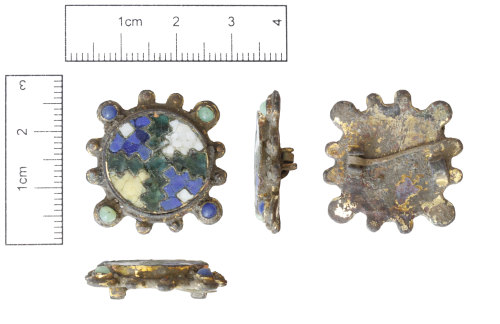
Rights Holder: Cambridgeshire County Council
CC License: ![]()
Image use policy
Our images can be used under a CC BY attribution licence (unless stated otherwise).
BROOCH
Unique ID: CAM-E71DC1
Object type certainty: Certain
Workflow
status: Published ![]()
A late 10th to 11th century AD Cloisonné disc brooch. See Buckton 1986, p.12, fig.4, no.11 and Weetch Type 20.A. cross with lobes.
This brooch weighs 6.89g, and measures 25.0mm on the same axis as the pin x 25.7mm. The back-plate has a thickness of 1.6mm and is circular with twelve approximately equally spaced rounded lobes projecting out from the edge. Four of these lobes have a diameter ranging between 4.5mm - 5.1mm. The upper surface of these four lobes have a copper-alloy collar, within which sits a glass sphere. The two slightly larger lobes are positioned opposite each other across the brooch and contain a pale green sphere. The other two opposing lobes contain mid-blue glass spheres. Between each of these four large lobes are two smaller lobes. These have a diameter ranging between c. 2.8mm - 3.3mm. At the centre of each of the eight small lobes is a dome-topped pellet of copper-alloy.
A strip of copper-alloy sheet, of c.2.1mm width, forms a collar on the front surface of the plate. This collar is soldered on to form a circular field of c.19.2mm diameter. The solder has failed on one end of this collar and the transverse blunt-ended terminal of the strip has pulled away from the butted together join. Within this circular field sheet copper-alloy is shaped to form cloisonné cells. These cells form a wavy equal-armed cross. The cross is filled with mid to dark translucent green glass. The space between two arms of the cross, one of the quarters, is filled with white enamel. The quarter opposite this is filled with a creamy pale-yellow enamel. The other two opposing quarters are filled with a mid-blue enamel however, each of these two quarters also has a single white square of enamel placed at the centre next to the external edge. Surviving patches of gilt indicate that originally all of the copper-alloy elements on the upper surface were gilded. The back-plate and central field have a combined thickness of 4.4mm.
The reverse surface and edges of the back-plate were also gilt with large quantities still surviving. A double lug, for a pin-bar, and catch-plate have been soldered onto the reverse surface of the back-plate. These are in line with one axis of the arms of the cross, on the enamelled field on the front of the brooch. The lugs are rectangular in shape with a rectangular cross-section. Each has a length of c.2.8mm, thickness of c.0.8mm and height of 2.4mm & 3.0mm. The two lugs are set apart by a gap of 2.0mm. The pin-bar survives between the lugs as does the hinged pin. The pin appears to have a circular cross-section along the length of the shank. The diameter is 1.0mm close to the pin-bar and lugs, tapering to a fine pointed tip. The pin flattens out to a rectangular cross-section just before it wraps around the pin-bar. As the pin wraps around the bar it has a width of 1.3mm. The pin-loop terminal stops before touching the underside of the pin-shank. Sufficient access cannot be made to measure the gap between the shank and loop terminal. The pin is bent and as a result of this only an approximate length of c. 19.0mm of the pin shaft can be measured.
The catch-plate is separated from the lugs by a gap of 12.2mm. It has a rectangular cross-section and measures a length of 2.8mm and thickness of 0.9mm. The catch-plate has been bent over completely, the tip of the catch now resting against the back-plate. This now occupies a width of 4.0mm and has a height of 2.2mm.
Class:
cloisonné enamelled (Weetch Type 20)
Sub class: Saunderton type (Weetch Type 20.A)
Subsequent actions
Subsequent action after recording: Returned to finder
Chronology
Broad period: EARLY MEDIEVAL
Subperiod from: Late
Period from: EARLY MEDIEVAL
Subperiod to: Early
Period to: MEDIEVAL
Date from: Circa AD 950
Date to: Circa AD 1100
Dimensions and weight
Quantity: 1
Weight: 6.89 g
Discovery dates
Date(s) of discovery: Tuesday 1st August 2017 - Thursday 31st August 2017
Personal details
This information is restricted for your access level.
Materials and construction
Primary material: Copper alloy
Secondary material: Enamel
Completeness: Complete
Surface Treatment: Gilded
Spatial metadata
Region: Eastern (European Region)County or Unitary authority: Cambridgeshire (County)
District: South Cambridgeshire (District)
To be known as: South Cambridgeshire District Area
Spatial coordinates
Grid reference source: From a paper map
Unmasked grid reference accurate to a 10 metre square.
References cited
| Author | Publication Year | Title | Publication Place | Publisher | Pages | Reference | |
|---|---|---|---|---|---|---|---|
| Buckton, D. | 1986 | Late 10th and 11th-century cloisonne enamel brooches |
Similar objects

Find number: NLM-59ADAF
Object type: BROOCH
Broadperiod: ROMAN
Copper alloy brooch. Cast plate brooch, Mackreth type British Plate 3.a3. A circular plate with a central reserved spot which is at the centr…
Workflow: Awaiting validation![]()

Find number: CAM-E5FAE1
Object type: BROOCH
Broadperiod: EARLY MEDIEVAL
A gilt copper-alloy cloisonné enamel brooch of Early-Medieval date (late 10th to 11th Century AD). The body of the brooch is circular in sha…
Workflow: Awaiting validation![]()

Find number: IOW-E3A58B
Object type: BROOCH
Broadperiod: ROMAN
An incomplete Roman copper-alloy and enamelled flat disc brooch (AD 80-250).
The pin and part of the catch-plate are missing.
The plate…
Workflow: Awaiting validation![]()



